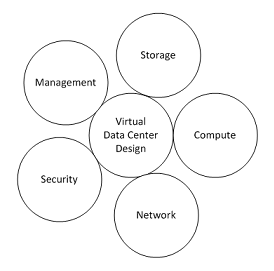The virtual data center architect must be able to take a holistic approach to data center design. This means that for every decision made, the architect must understand how the environment as a whole will be impacted.
An architect is required to be, at the very least, familiar with all aspects of the data center. They must understand how the different components of a data center, such as storage, networking, computing, security, and management, are interconnected, as shown in the following diagram:

It has become very important to understand how any decision or change will impact the rest of the design. Identifying dependencies becomes an important part of the design process. If a change is made to the network, how are computing, management, and storage resources affected? What other dependencies will this introduce in the design? Failing to take a holistic approach to design can result in unnecessary complications during the design process, and potentially costly fixes after the design is implemented.



